Tarot cards have long fascinated individuals interested in the mystical and esoteric. From its ancient origins to its modern-day applications, the role of tarot in occult and esoteric practices has captured the imagination of many. In this comprehensive article, we will explore the history of tarot, the symbolism within the cards, their use in divination, spiritual guidance, rituals and spellwork, and their connections to astrology. Additionally, we will discuss the ethics of tarot readings, tips for choosing the right deck, and insights into learning and developing intuitive reading skills. Whether you are a tarot enthusiast or simply curious about this ancient art, join us as we dive deep into the captivating world of tarot and its multifaceted role in the occult and esoteric realms.
Contents
- History of Tarot
- Symbolism in Tarot
- Tarot and Divination
- The Tarot Deck
- Using Tarot for Spiritual Guidance
- Tarot in Rituals and Spellwork
- Tarot and Astrology
- The Ethical Use of Tarot
- Choosing the Right Tarot Deck
- Learning Tarot
- Experiences and Testimonials
- The Future of Tarot
- Conclusion
-
Frequently Asked Questions
- What is tarot divination?
- How accurate are tarot readings?
- Can anyone learn to read tarot cards?
- What are the major and minor arcana in tarot?
- Are there different variations of tarot decks?
- How can tarot cards be used for spiritual guidance?
- What is the connection between tarot and astrology?
- How can I choose the right tarot deck for me?
- Is it necessary to have psychic abilities to read tarot?
- How can I learn tarot card meanings?
- References
History of Tarot
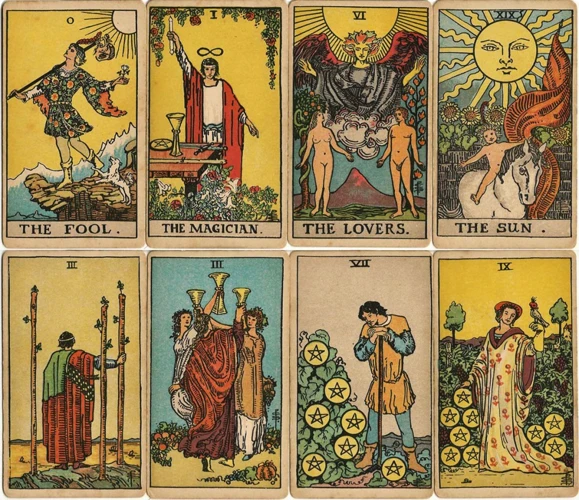
The history of tarot is shrouded in mystery and debate. Tarot divination has seen various forms throughout the centuries, with the precise origins of the cards remaining obscure. Some believe that tarot cards were derived from ancient Egyptian hieroglyphs, while others trace their roots back to medieval Europe. Regardless of its origin, tarot gradually evolved and gained popularity within Western mysticism. It wasn’t until the 18th century that tarot cards began to be used for divination purposes, unlocking a deeper understanding of the human psyche and unfolding spiritual truths. Over time, several notable tarot decks have emerged, each with its own unique symbolism and interpretation, such as the Rider-Waite-Smith and Marseille decks. These decks continue to be influential in the practice of tarot, providing a rich tapestry of history and symbolism for readers and enthusiasts alike.
Origins of Tarot
- Early Speculations: The exact origins of tarot cards are shrouded in speculation and theories. Some believe that tarot cards originated in ancient Egypt, pointing to similarities between tarot and Egyptian hieroglyphs. However, there is no concrete evidence to support this claim.
- Medieval Europe: The earliest concrete evidence of tarot cards can be traced back to medieval Europe. The first known tarot deck was created in the 15th century in Italy. These early decks, known as the Visconti-Sforza decks, were lavish and hand-painted, often used for aristocratic leisure.
- Playing Card Connection: Tarot cards share a connection with playing cards, as both use a similar structure of suits and numbered cards. The Tarot de Marseille, a popular tarot deck from the 16th century, adopted the same suits of cups, coins, swords, and batons that are found in modern playing cards.
- Hermetic Influences: In the 18th century, Jean-Baptiste Alliette, known as Etteilla, introduced occult and symbolic interpretations to tarot. Etteilla’s work merged tarot with hermetic principles, incorporating ideas from alchemy, astrology, and divination.
- Symbolism and Mysticism: As tarot evolved, it gained significance in occult and esoteric circles. The Rider-Waite-Smith tarot deck, created by Pamela Colman Smith and Arthur Edward Waite in the early 20th century, brought a new level of symbolism and mysticism to the cards, paving the way for future tarot decks.
While the true origins of tarot remain elusive, it is clear that tarot cards have undergone a fascinating journey throughout history. From speculative theories to medieval Europe and the incorporation of mysticism, tarot’s origins provide a rich tapestry of exploration and interpretation for those who seek a deeper understanding of these mystical cards.
Evolution of Tarot in Esoteric Practices
The evolution of tarot in esoteric practices has been a fascinating journey, intertwined with the development of occult and spiritual traditions. Over the centuries, tarot has transitioned from being a simple card game played by the noble class to a profound tool for divination and esoteric exploration. One significant milestone in this evolution occurred during the 18th century with the publication of Antoine Court de Gébelin’s “Le Monde primitif” which speculated on the ancient Egyptian origins of tarot cards. This notion sparked immense curiosity and interest, leading to a surge in the study and practice of tarot as a conduit for accessing esoteric knowledge.
As tarot gained popularity, influential figures such as Eliphas Lévi and the Golden Dawn further contributed to its evolution by incorporating tarot into their occult systems. Lévi, a renowned French occultist, associated each card with a corresponding Hebrew letter, establishing a connection between the tarot and Kabbalah. The Golden Dawn, a secretive esoteric society, developed a complex system of tarot symbolism and correspondences, emphasizing the tarot’s role as a spiritual tool for personal development and enlightenment.
The 20th century witnessed another wave of evolution for tarot as it became more accessible to the masses. The influential Rider-Waite-Smith deck, created by Arthur Edward Waite and Pamela Colman Smith, introduced innovative imagery and symbolism. This deck deviated from the traditional occult symbolism and incorporated more relatable and accessible imagery, paving the way for a broader audience to engage with tarot.
Today, the evolution of tarot in esoteric practices continues as contemporary practitioners explore new ways to apply tarot in spiritual development, shadow work, and manifestation practices. Tarot is now recognized as a powerful tool for self-reflection, personal growth, and spiritual guidance. As the art and practice of tarot continue to evolve, it remains deeply intertwined with esoteric practices, offering seekers a pathway to explore the mysteries of the inner self and the universe.
Symbolism in Tarot
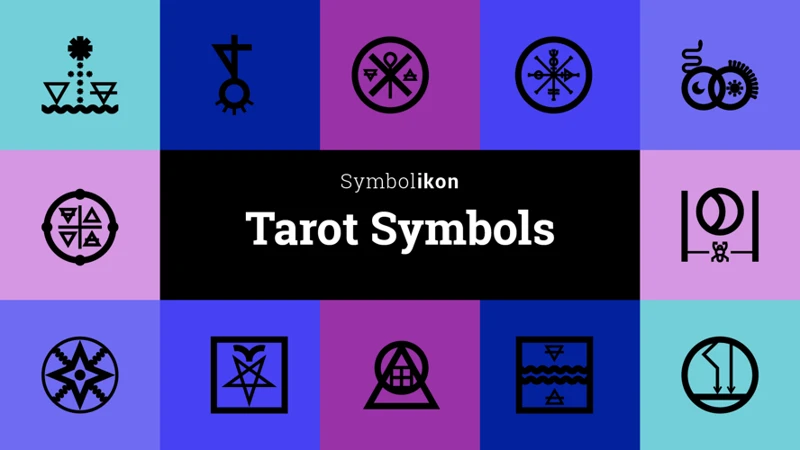
The symbolism within tarot cards is a key aspect of their power and allure. Tarot decks consist of the Major Arcana and the Minor Arcana, each filled with rich imagery and profound meanings. The Major Arcana represents major life events and spiritual lessons, such as the Fool’s journey through life’s ups and downs. Each card in this arcana represents a unique archetype, from the Empress symbolizing nurturing and abundance to Death signifying transformation and rebirth. On the other hand, the Minor Arcana reflects the daily experiences and challenges we encounter, divided into four suits – Wands, Cups, Swords, and Pentacles – each representing different aspects of life. The cards in the Minor Arcana provide insight into relationships, emotions, intellect, and material aspects of life. The combination of colors, symbols, and numerology within the tarot cards opens a gateway to the subconscious, allowing interpreters to tap into their intuition and unlock hidden truths.
Major Arcana
The Major Arcana is a key component of the tarot deck, consisting of 22 cards that hold significant spiritual and symbolic meaning. Each card in the Major Arcana represents a different archetype or theme, encompassing various aspects of the human experience. These cards often depict powerful figures, mythical creatures, or symbolic scenes that convey deep psychological and spiritual insights. The journey depicted in the Major Arcana is often interpreted as a metaphorical path of personal growth and transformation.
From the enchanting Fool card, symbolizing new beginnings and embracing the unknown, to the profound and introspective World card, representing fulfillment and completion, the Major Arcana cards encompass a wide range of human emotions and experiences. Each card carries its own distinct energy and message, inviting reflection, contemplation, and introspection.
The Major Arcana cards can be used in a tarot spread to gain insight into specific aspects of life or to provide a comprehensive overview of the querent’s journey. They serve as profound archetypal images that tap into the collective unconscious, allowing for a deeper understanding of ourselves and the world around us. Whether used for divination or self-reflection, the Major Arcana cards hold a transformative power that can provide guidance, inspiration, and illumination on our spiritual path.
As you delve into the Major Arcana, take the time to explore the unique symbolism and interpretation associated with each card. Allow yourself to connect with the archetypal energies they embody and contemplate how they resonate with your own life experiences. The Major Arcana is a gateway to self-discovery and a powerful tool for spiritual growth and enlightenment.
Minor Arcana
The Minor Arcana is a significant component of the tarot deck, comprising four suits: Wands, Cups, Swords, and Pentacles. Each suit consists of 14 cards, including Ace through Ten and the Court Cards (Page, Knight, Queen, and King). These cards represent the everyday aspects of life and offer insights into various situations and emotions. The Wands suit symbolizes creativity, ambition, and inspiration, while the Cups suit represents emotions, relationships, and intuition. The Swords suit embodies intellect, communication, and challenges, while the Pentacles suit signifies practicality, material wealth, and earthly matters. Each card in the Minor Arcana carries its own unique energy and meaning, providing valuable guidance in matters of career, relationships, personal development, and more. When conducting a tarot reading, the Minor Arcana cards work in conjunction with the Major Arcana to create a holistic and comprehensive interpretation of the situation at hand. Their blend of elemental symbolism and numerology adds depth and complexity, allowing tarot readers to tap into the subtle nuances of life’s experiences and offer profound insights and guidance.
Tarot and Divination
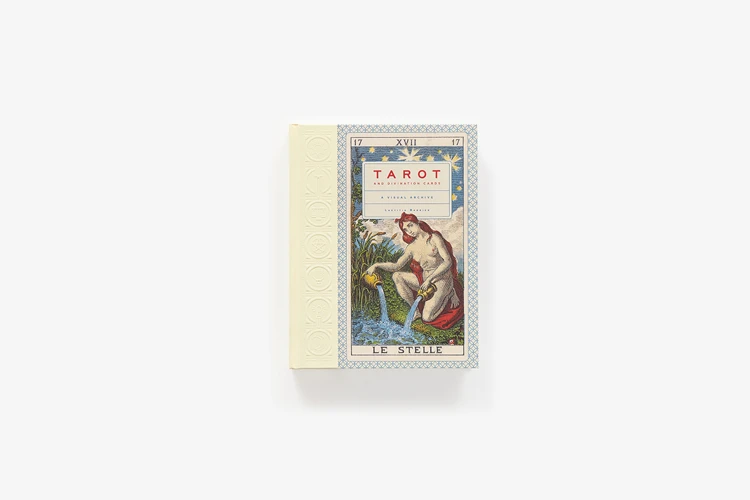
Tarot and divination have a long-standing relationship, with tarot cards serving as powerful tools for gaining insight and guidance. Tarot reading involves using a deck of tarot cards to access one’s intuition and tap into the unseen realms. Various methods of tarot reading exist, ranging from simple single-card pulls to more complex spreads that delve deep into specific areas of one’s life. Each card carries its own symbolic meaning, and the placement within a spread contributes to the overall message and interpretation. Interpretation of tarot spreads requires a combination of knowledge of traditional card meanings, intuition, and the ability to connect the cards’ symbolism to the querent’s specific situation. The art of tarot divination allows individuals to gain clarity, make informed decisions, and explore the unseen energies that shape their lives.
Methods of Tarot Reading
- Celtic Cross: The Celtic Cross is one of the most well-known and widely used tarot spreads. It consists of ten cards that offer insight into various aspects of a situation or question. The cards are laid out in a specific pattern, with each position representing different aspects of the querent’s life and the influences at play.
- Three-Card Spread: The Three-Card Spread is a simple yet effective method for gaining quick and focused insights. The first card represents the past, the second card represents the present, and the third card represents the future or potential outcomes. This spread is helpful when seeking immediate answers or gaining a general overview of a situation.
- One-Card Draw: The One-Card Draw is the simplest method of tarot reading, involving pulling a single card to gain insight into a specific question or situation. While it may provide a concise answer, it can also serve as a starting point for deeper exploration and guidance.
- Relationship Spread: The Relationship Spread is often used to gain insights into the dynamics and issues within a partnership. It typically involves a series of cards that represent the individual’s perspective, the partner’s perspective, and the overall energy of the relationship. This spread can provide valuable insights into communication, challenges, and potential growth within the relationship.
- Self-Reflection Spread: The Self-Reflection Spread is designed to encourage introspection and personal growth. It may consist of a series of cards that represent the individual’s strengths, weaknesses, opportunities, and potential outcomes. This spread can help explore areas for self-improvement, gain clarity on personal goals, and uncover hidden aspects of oneself.
These are just a few examples of the various methods of tarot reading that individuals can use to seek guidance and gain insight into different aspects of their lives. Tarot readers may also develop their own unique spreads tailored to specific needs or questions. It’s important to remember that the interpretation of tarot cards and spreads is deeply personal and can vary based on the reader’s intuition and connection with the cards.
Interpretation of Tarot Spreads
Interpretation of tarot spreads is an essential skill for anyone practicing divination with tarot cards. When laying out a spread, the position of each card carries significance and contributes to the overall message and insights revealed. To begin the interpretation process, it’s crucial to consider the individual cards within the spread and their corresponding meanings. Each card holds its own symbolism and represents different aspects of life, emotions, and experiences. By examining the interactions and relationships between the cards, readers can uncover deeper layers of meaning and gain a holistic understanding of the situation at hand. Paying attention to the placement of cards in relation to past, present, and future positions can provide valuable insights into the timeline of events or the progression of a situation. Additionally, the proximity of certain cards to one another and the presence of major arcana cards can indicate key themes, challenges, or potential outcomes. Intuition plays a vital role in the interpretation process, as it allows the reader to tap into their inner wisdom and make intuitive connections between the cards. Each reading is unique, and the interpretation of tarot spreads requires a flexible and open mindset that allows for personal interpretation and connection to the querent’s specific circumstances. Through careful analysis, symbolism, and intuition, the interpretation of tarot spreads becomes a powerful tool for gaining insight, guidance, and potential solutions.
The Tarot Deck
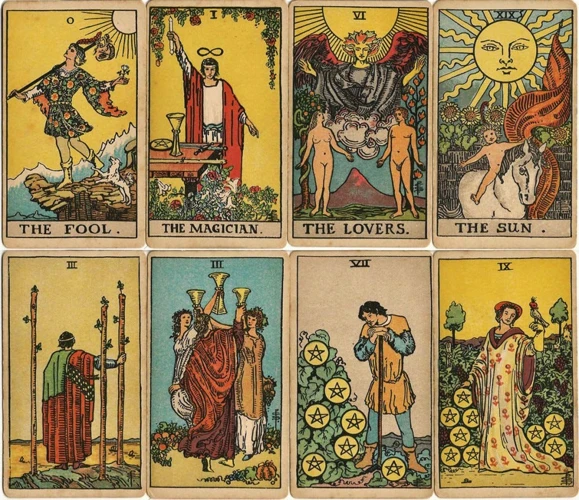
The tarot deck is an essential tool in the practice of tarot reading and divination. A traditional tarot deck consists of 78 cards, divided into two main categories: the Major Arcana and the Minor Arcana. The Major Arcana comprises 22 cards, each representing archetypal experiences and significant life events. These cards, such as The Fool, The Magician, and The Judgement, hold profound symbolism and carry powerful spiritual messages. On the other hand, the Minor Arcana consists of 56 cards divided into four suits: Wands, Cups, Swords, and Pentacles, each with their own set of meanings related to different aspects of life. The structure of a traditional tarot deck allows for a comprehensive exploration of the human experience and offers guidance on various areas of life, including love, relationships, career, and spirituality. While there are variations of tarot decks available, each with its unique art styles and interpretations, they all adhere to the fundamental structure and symbolism of the cards, ensuring the consistency and reliability of tarot as a divination tool.
Structure of a Traditional Tarot Deck
When exploring the structure of a traditional tarot deck, there are several key components to consider. Firstly, a standard tarot deck consists of 78 cards, divided into two main categories: the Major Arcana and the Minor Arcana. The Major Arcana cards are often seen as the core archetypes and represent significant life lessons and experiences. There are 22 cards in the Major Arcana, starting with The Fool and ending with The World.
The Minor Arcana, on the other hand, comprises 56 cards and is further divided into four suits: Wands, Cups, Swords, and Pentacles. Each suit contains ten numbered cards (Ace to Ten) and four court cards (Page, Knight, Queen, and King). The Minor Arcana cards typically reflect more day-to-day situations and influences.
In addition to the suits and the Major Arcana, traditional tarot decks also contain symbolism in the form of imagery and illustrations. These images are rich in esoteric symbols, numerology, and astrology, making each card a visual representation of profound concepts and insights. The combination of these elements within a traditional tarot deck allows for a comprehensive exploration of the human experience and spiritual journey.
It’s important to note that while the structure of a traditional tarot deck generally follows the pattern outlined above, there are variations among different decks. Some decks may have different names for the suits or alternative interpretations of the Major Arcana. However, the underlying framework of the deck remains consistent, providing a foundation for tarot readers to connect with the cards’ meanings and unlock their wisdom and guidance.
Variations of Tarot Decks
There are a multitude of variations when it comes to tarot decks, each offering a unique perspective and interpretation of the cards. These variations can differ in terms of artwork, symbolism, and even the number of cards in the deck. Here are a few notable variations of tarot decks:
1. Rider-Waite-Smith (RWS) Deck: This is one of the most popular and widely recognized tarot decks. Illustrated by Pamela Colman Smith and published in 1910, the RWS deck introduced significant innovations in card design and symbolism. Its clear and vibrant imagery, combined with the comprehensive guidebook by A.E. Waite, made it accessible to beginners while still carrying deep esoteric meanings.
2. Marseille Tarot: This deck is considered one of the earliest and most influential tarot decks, with roots dating back to the early 18th century. The Marseille Tarot features simple, unillustrated pip cards and traditional imagery. It is known for its emphasis on astrological correspondences and its straightforward, no-frills approach to divination.
3. Thoth Tarot: Created by Aleister Crowley and Lady Frieda Harris, the Thoth Tarot is renowned for its intricate symbolism and occult references. Published in 1944, this deck reflects Crowley’s esoteric philosophy and incorporates elements from various mystical traditions. It features vibrant, surrealistic artwork that invites deep exploration and introspection.
4. Tarot de Marseille: This is a traditional style tarot deck that closely resembles the historical Marseille Tarot. It is characterized by its simple medieval-inspired artwork and its emphasis on numerology and symbolism. The Tarot de Marseille is a favorite among purists and those seeking a more traditional approach to tarot reading.
5. Oracle Decks: While not strictly tarot decks, oracle decks are often used in conjunction with or as alternatives to traditional tarot. Oracle decks typically consist of cards with unique themes and messages, and they offer a more flexible and intuitive approach to divination.
It’s important to note that this list represents just a fraction of the many variations available. Each deck has its own distinct energy and resonance, so choosing a deck is a highly personal decision that should be based on one’s connection to the artwork, symbolism, and style of interpretation. Ultimately, finding the right deck involves exploring and discovering the deck that resonates with your own intuition and preferences.
Using Tarot for Spiritual Guidance
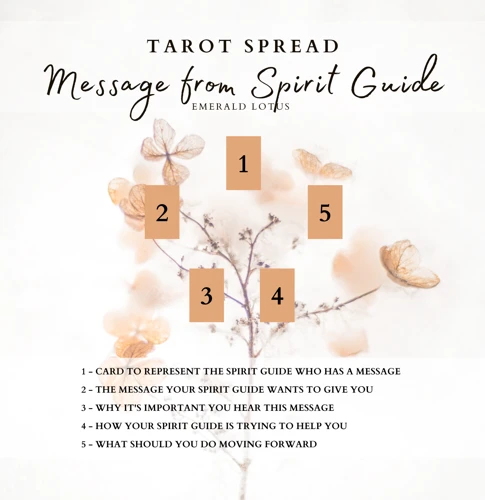
Tarot holds a profound capacity for providing spiritual guidance to those who seek it. When utilizing tarot cards for spiritual purposes, individuals have the opportunity to connect with their intuition on a deeper level. Through the act of shuffling the cards and selecting specific ones for a reading, one can tap into their inner wisdom and receive insights from the divine. Tarot acts as a conduit for accessing the collective unconscious, allowing individuals to gain clarity, insight, and guidance in their spiritual journeys. Whether it be through a single card draw or a complex spread, tarot offers a space for self-reflection and growth. It empowers individuals to explore their innermost thoughts, feelings, and desires, unveiling hidden truths and expanding their spiritual consciousness. By embracing tarot as a tool for spiritual guidance, one can embark upon a transformative journey towards self-discovery and enlightenment.
Connecting with Intuition
Connecting with intuition is a fundamental aspect of working with tarot cards. Intuition is defined as the ability to understand or instinctively know something without the need for conscious reasoning. When it comes to tarot readings, it is important for the reader to tap into their intuitive abilities to gain deeper insights into the cards’ meanings and the messages they hold.
The process of connecting with intuition begins by creating a calm and focused mindset. This can be achieved through various techniques, such as deep breathing exercises, meditation, or visualization. By quieting the mind and releasing distractions, the reader becomes more receptive to the subtle energies present in the tarot cards.
Once in this receptive state, the reader can begin to trust their inner knowing and instincts. This involves paying attention to subtle cues, gut feelings, and the overall energy of the cards. It is important to remember that there is no right or wrong way to interpret the cards, as intuition is a deeply personal experience.
Another helpful practice for connecting with intuition is journaling. After a tarot reading, the reader can reflect on the cards drawn and jot down any thoughts, impressions, or insights that come to mind. This process allows for a deeper exploration of the intuitive messages received and can further enhance the reader’s connection with their inner wisdom.
Ultimately, connecting with intuition is an ongoing process that requires practice, trust, and self-awareness. It is through this connection that tarot readings become more insightful, meaningful, and empowering. By accessing their intuition, readers can unlock the hidden depths of the tarot cards and gain a deeper understanding of themselves and the world around them.
Tapping into the Collective Unconscious
Tapping into the collective unconscious is a profound aspect of using tarot for spiritual guidance. The concept of the collective unconscious was introduced by renowned psychologist Carl Jung, who believed that there exists a shared reservoir of knowledge and wisdom that is inherited by all of humanity. Tarot cards are viewed as a powerful tool for accessing this collective unconscious. When a tarot reader connects with the cards, they open a channel to tap into this universal knowledge, allowing insights and intuitive information to flow. By delving into the symbolism and archetypes present in the tarot deck, readers can access profound truths and guidance that extends beyond their individual experiences. The collective unconscious acts as a wellspring of wisdom, offering a deeper understanding of ourselves, our situations, and the collective human experience. Through tarot, individuals can tap into this vast reservoir of knowledge and gain valuable insights to support their spiritual growth and development.
Empowering Self-Reflection and Growth
- Tarot cards serve as powerful tools for self-reflection and personal growth. Through the archetypal images and symbols depicted on the cards, individuals can delve deep into their subconscious minds and gain insights into their true selves.
- Self-reflection is an essential aspect of personal development, allowing individuals to gain a deeper understanding of their thoughts, emotions, and behaviors. Tarot cards provide a visual representation of these inner workings, helping individuals make connections and uncover patterns that may have been previously hidden.
- The process of interpreting tarot cards requires individuals to tap into their intuition and trust their instincts. This practice enhances self-awareness and encourages individuals to listen to their inner voice, fostering a stronger sense of self-confidence and empowerment.
- Tarot can uncover limiting beliefs or thought patterns that may be hindering personal growth. By bringing these beliefs to the surface, individuals can work towards releasing and transforming them, paving the way for personal development and positive change.
- The act of engaging with tarot cards also provides a safe and non-judgmental space for self-exploration. It allows individuals to confront their fears, desires, and aspirations in a supportive and introspective manner.
- Tarot cards can act as a mirror to reflect one’s strengths and weaknesses. This reflection assists individuals in recognizing their potential and areas for improvement, enabling them to set goals and embark on a journey of self-improvement.
- As individuals continue to use tarot for self-reflection and growth, they develop a deeper connection to their own intuition and inner wisdom. This connection allows them to navigate life’s challenges with increased clarity, confidence, and resilience.
Tarot in Rituals and Spellwork
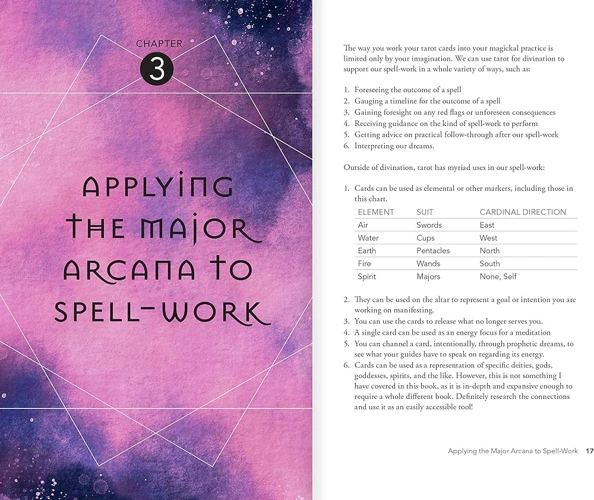
Tarot cards play a significant role in rituals and spellwork within the realm of the occult and esoteric practices. The use of tarot in magic enables individuals to tap into the subconscious mind and access deeper levels of consciousness. Tarot decks can serve as powerful tools for manifestation, intention-setting, and divination during these rituals. By utilizing specific cards or spreads, practitioners can focus their intentions and align them with the energy of the tarot to amplify their spellwork. Additionally, tarot-based rituals can be created to honor specific deities, perform ceremonies for personal growth, or enhance spiritual practices. The versatile nature of tarot allows practitioners to incorporate their own intuitive interpretations and create personalized rituals that align with their specific intentions and desires.
Tarot as a Tool in Magic
Tarot as a Tool in Magic
The tarot is not only used for divination and spiritual guidance but also as a powerful tool in magic. Many practitioners of magic incorporate tarot cards into their spellwork and rituals to enhance their intentions and connect with higher realms of consciousness. The symbolic imagery and archetypal energies represented in the tarot cards make them a valuable resource for focusing intent and harnessing spiritual energy.
When using tarot in magic, practitioners often select specific cards that align with their desired outcome or intention. These chosen cards serve as symbolic representations or sigils that are charged with spiritual energy. Through rituals, meditations, and incantations, the practitioner infuses the tarot cards with their intention, amplifying their magical potency.
The use of tarot in magic can be approached in various ways. Some practitioners may integrate tarot cards into spellwork by placing them on an altar or creating a sacred space where the cards act as focal points for the magic being performed. Other practitioners may incorporate tarot cards into rituals, using them as divination tools to gain insight into the energies present and to guide their magical workings.
One common way to utilize tarot in magic is through the creation of custom spreads specifically designed for spellcasting. These spreads may incorporate strategic card placements and formations that correspond to different aspects of the desired outcome. The tarot cards then serve as a map or blueprint for the practitioner to follow, helping them navigate the magical journey and manifest their intentions.
It is important to note that when using tarot as a tool in magic, the practitioner should have a deep understanding of both tarot symbolism and magical practices. This allows them to tap into the inherent power of the cards and effectively channel their magical intentions. Additionally, respect for the spirits and energies involved is crucial, as the tarot acts as a conduit for connecting with spiritual realms.
The incorporation of tarot into magical practices opens up new avenues for personal growth, manifestation, and spiritual exploration. By using the tarot as a tool in magic, practitioners can harness the profound wisdom and energy contained within the cards, bringing about transformative experiences and aligning with their highest intentions.
Creating Tarot-based Rituals
- Setting Intentions: When creating a tarot-based ritual, it is essential to set clear intentions. Before starting the ritual, take a moment to reflect on the purpose and desired outcome of the ritual. This could be anything from manifesting a specific goal, seeking guidance, or connecting with higher spiritual energies.
- Selecting Appropriate Cards: Choose tarot cards that align with your intentions and the energy you wish to invoke. You can select cards based on their traditional meanings or personal associations. For example, if you’re seeking abundance, you might choose cards related to prosperity or growth.
- Creating Sacred Space: Prepare a dedicated space for your ritual. Cleanse the area by burning sage or lighting candles. Arrange the selected tarot cards in a way that feels meaningful to you, such as in a spread that represents your intentions or in a circle to create a sacred boundary.
- Invoking Tarot Energies: To enhance the ritual, you can invoke the energies of the chosen tarot cards by meditating on their meanings or reciting affirmations that resonate with their symbolism. Allow yourself to connect deeply with the cards and the energies they represent.
- Reading the Cards: Once you’ve invoked the tarot energies, begin the card reading. Use your intuition to interpret the cards and gain insight into your intentions or questions. Pay attention to the symbolism, colors, and emotions evoked by the cards. Take your time to reflect on the messages they convey.
- Closing the Ritual: After the card reading, express gratitude for the guidance received and the energies that were present during the ritual. You can close the ritual by blowing out the candles, offering thanks to any spiritual guides you invoked, or performing a closing affirmation or prayer.
Tarot and Astrology
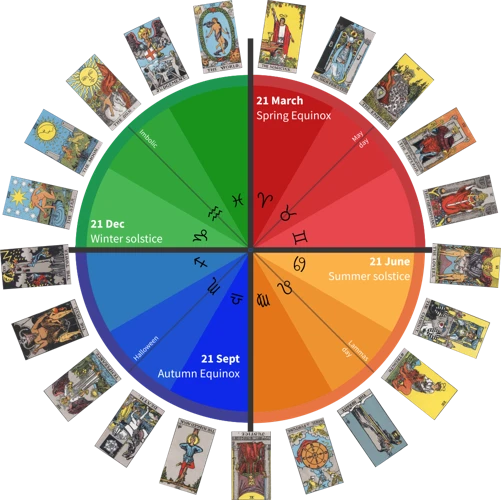
Tarot and astrology share a deep connection, intertwining the cosmic energies and archetypal symbolism. In tarot, each card of the major arcana corresponds to a specific astrological sign or planet, creating a bridge between the two mystical systems. The correlations between tarot cards and astrological signs offer a deeper layer of interpretation and expand the possibilities of divination. By integrating tarot and astrology, readers can gain profound insights into personal strengths, challenges, and life’s unfolding journey. Additionally, astrological readings can provide a broader context for tarot spreads, enhancing the understanding of the energies at play. While tarot and astrology are distinct practices, their collaboration adds a multidimensional perspective, enriching the spiritual exploration and guidance tarot can provide.
Correlations between Tarot Cards and Astrological Signs
Correlations between tarot cards and astrological signs provide a fascinating layer of depth and insight to tarot readings. Many tarot decks incorporate astrological symbolism into their designs, aligning specific cards with corresponding zodiac signs and planetary associations. For example, The Emperor card is often associated with Aries, representing power, authority, and leadership traits, which are characteristics often associated with this zodiac sign. Similarly, The High Priestess card is commonly linked to the sign of Pisces, embodying intuition, spirituality, and mystery. These correlations allow tarot readers to delve into the astrological influences surrounding a querent’s life and situation, providing a broader perspective on their personality, life events, and potential outcomes. The interplay between tarot and astrology allows for a more comprehensive and nuanced interpretation of the cards, weaving together the celestial influences with the archetypal energies depicted in the tarot.
Integrating Tarot and Astrological Readings
Integrating tarot and astrological readings can provide a powerful and comprehensive approach to divination and self-discovery. By combining the wisdom of the tarot cards with the insights of astrology, practitioners can gain deeper insights into their own lives and the world around them. Tarot and astrology both offer unique perspectives and symbolism that can complement and enhance one another.
One way to integrate tarot and astrology is by using the astrological correspondences associated with each tarot card. Each card in the tarot deck is said to correspond to a specific astrological sign, planet, or house. By understanding these correspondences, readers can draw upon astrological knowledge to provide additional layers of meaning to their readings. For example, if a tarot card is associated with the sign of Leo, the reader can consider the qualities and themes associated with Leo to gain a deeper understanding of the card’s message.
Another way to integrate tarot and astrology is by incorporating astrological spreads into tarot readings. Instead of using a traditional tarot spread, the reader can use a spread that is based on astrological patterns, such as the zodiac spread or the celestial spread. These spreads take into account the positions of the planets and the astrological houses, providing a unique framework for exploring specific areas of life or gaining clarity on particular questions.
Astrological transits and progressions can also be used in combination with tarot readings. Transits refer to the current positions of the planets in relation to an individual’s birth chart, while progressions represent a symbolic and gradual movement of the birth chart over time. By looking at the tarot cards in conjunction with these astrological movements, readers can gain deeper insights into specific periods of life and the lessons or challenges that may be present.
Integrating tarot and astrology is a dynamic and personalized approach to divination, allowing for a more comprehensive exploration of individual circumstances and life events. The combination of these two ancient practices opens the door to a deeper understanding of the self, providing guidance, clarity, and empowerment along one’s spiritual journey.
The Ethical Use of Tarot
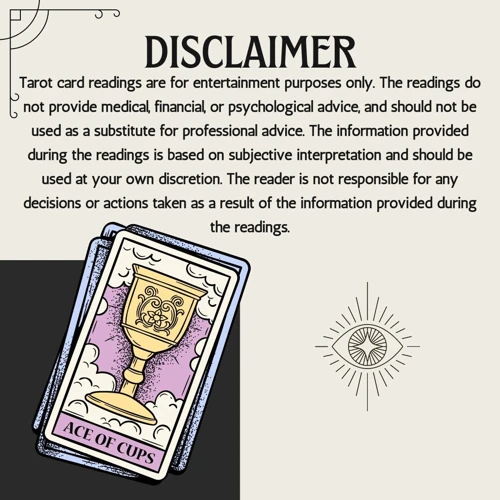
When it comes to the ethical use of tarot, there are several important considerations to keep in mind. First and foremost, confidentiality and consent are key aspects of conducting tarot readings. It is crucial to respect the privacy of individuals seeking guidance and to obtain their consent before delving into their personal matters. Additionally, respecting boundaries and free will is essential. Tarot should never be used to manipulate or control others, but rather to offer insight and guidance as a tool for personal growth. Practitioners should empower their clients to make their own decisions based on the information provided, encouraging them to exercise their free will. By upholding these ethical principles, tarot readings can be conducted in a responsible and respectful manner, fostering a safe space for exploration and self-discovery.
Confidentiality and Consent in Tarot Readings
Confidentiality and consent play crucial roles in conducting ethical and responsible tarot readings. Tarot readers must respect the privacy and confidentiality of their clients, ensuring that any personal information shared during a reading remains confidential. This includes not disclosing any sensitive details or the content of the reading to third parties without the explicit consent of the client. Additionally, obtaining the client’s consent before the reading begins is essential. This allows the client to actively participate in the reading, giving their permission for the reader to delve into their personal energy and explore the messages and insights that tarot cards provide. Consent ensures that the client feels comfortable and empowered throughout the reading process. Maintaining client confidentiality and obtaining consent builds trust and fosters a safe space for open communication, making the tarot reading experience more meaningful and beneficial for the client.
Respecting Boundaries and Free Will
Respecting boundaries and free will is an essential aspect of ethical tarot practice. Tarot readings should always be conducted with the utmost respect for the individual’s autonomy and personal boundaries. A skilled tarot reader understands that their role is not to impose their beliefs or decisions onto the querent, but rather to provide guidance and insight. It is crucial to prioritize the querent’s right to make their own choices and decisions, even if those choices differ from what the reader may perceive as the best course of action. Tarot should never be used as a tool to manipulate or control others, but rather as a means to empower individuals to make informed decisions based on their own free will. Respecting boundaries also extends to the confidentiality of the readings; it is necessary for the reader to maintain the privacy of the querent’s personal information and the content of the reading. By upholding these principles, tarot practitioners can ensure that their practice remains ethical, respectful, and empowering.
Choosing the Right Tarot Deck
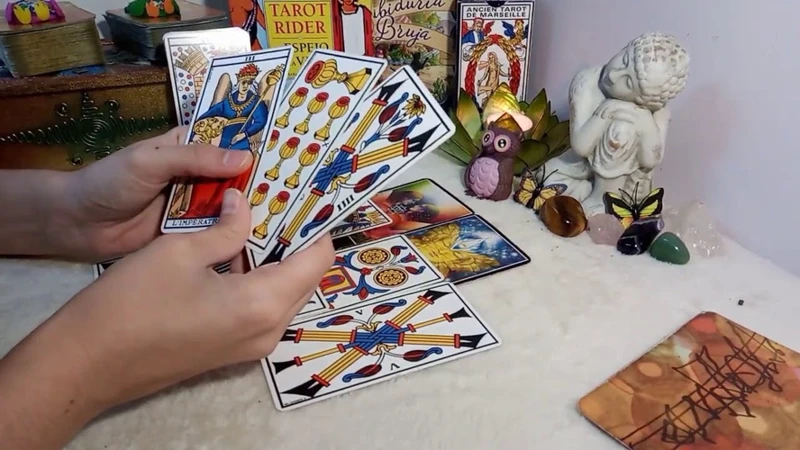
Choosing the right tarot deck is a highly personal and subjective process. When selecting a deck, it’s important to consider various factors that resonate with your individual preferences and intuitive connection. An essential consideration is to think about the artistic style and symbolism of the cards, as this will greatly impact your interpretation and understanding of the readings. Some decks may feature vibrant and whimsical artwork, while others may have a more minimalist or traditional design. It’s crucial to choose a deck that visually appeals to you and evokes a sense of connection. Additionally, you may also want to explore decks that align with specific themes or cultural backgrounds, such as decks inspired by mythology, astrology, or different spiritual traditions. Ultimately, finding a tarot deck that reflects your personality and resonates with your intuition is key to creating a fulfilling and meaningful tarot practice.
Considerations for Selecting a Deck
When selecting a tarot deck, there are several important considerations to keep in mind. First, consider the artwork and style of the deck. The imagery on the cards should resonate with you and evoke a sense of connection. Whether you prefer traditional, minimalist, or abstract designs, finding a deck that visually appeals to you is essential as it will enhance the intuitive connection with the cards. Another factor to consider is the symbolism used in the deck. Each deck may incorporate different symbols and archetypes, so it’s important to choose one that aligns with your personal beliefs and understanding. Additionally, think about the size and format of the cards. Some prefer larger cards for a more immersive experience, while others find smaller decks more practical for portability. It’s also worth considering the guidebook or companion book that comes with the deck. A detailed and comprehensive guidebook can be invaluable for beginners, providing explanations of card meanings and interpretations. Lastly, don’t be afraid to trust your intuition when selecting a deck. If you feel drawn to a particular deck or find yourself inexplicably drawn to its energy, it may be the right choice for you. Remember, the right deck is one that resonates with your unique personality and spiritual journey, allowing you to form a deep and meaningful connection with the tarot cards.
Affinity with Artistic Styles and Symbolism
Affinity with artistic styles and symbolism is an important consideration when choosing a tarot deck. Each tarot deck is adorned with unique artwork and symbolism that can greatly influence the reading experience. Some decks feature vibrant, colorful illustrations, while others may have more abstract or minimalist designs. Certain decks may be inspired by specific artistic movements, such as Art Nouveau or Surrealism, which can evoke different emotions and resonate with different individuals. It is crucial to find a deck that visually appeals to you and resonates with your personal aesthetic preferences. Additionally, the symbolism depicted on the cards should align with your understanding and interpretation of tarot. Each card carries symbolic meaning, and the imagery used can vary from deck to deck. For example, the High Priestess card may be represented differently in different decks, with variations in her attire, posture, or accompanying symbols. Take the time to explore different decks and familiarize yourself with their unique artistic styles and symbolism. This will ensure that you connect with the deck on a visual and intuitive level, enhancing your tarot reading experience.
Learning Tarot
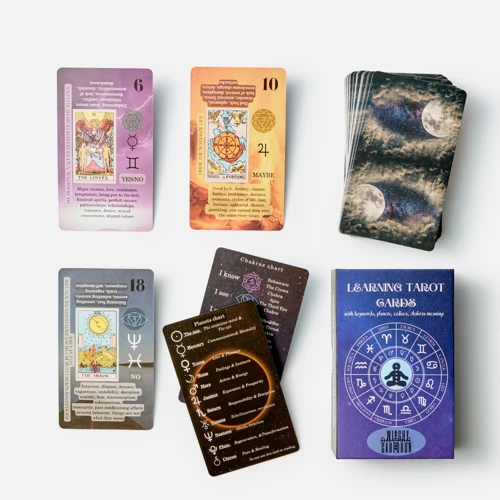
Learning tarot is an exciting and rewarding journey for those interested in unlocking the mysteries of the cards. While studying the traditional meanings of each tarot card is essential, it is equally important to develop intuitive reading skills. Studying tarot card meanings provides a solid foundation, enabling readers to understand the symbolism and themes within the cards. However, true mastery of tarot comes from honing one’s intuition and allowing the cards to speak directly to the reader. This involves developing a deep connection with the imagery, trusting one’s instincts, and interpreting the cards in the context of the unique situation at hand. Practicing regularly, journaling insights, and seeking guidance from experienced readers can enhance intuitive reading skills and encourage personal growth through tarot. Remember, tarot is a lifelong journey of discovery and self-reflection, and each reading offers an opportunity to delve deeper into the profound wisdom that tarot cards hold.
Studying Tarot Card Meanings
Studying tarot card meanings is a crucial aspect of developing proficiency in reading the cards. Each card in the tarot deck holds its own unique symbolism and interpretation, and understanding these meanings is essential for conducting accurate and insightful readings. To begin studying tarot card meanings, it is recommended to start with the Major Arcana. These cards represent significant life events and archetypal energies. Take the time to familiarize yourself with the imagery and symbolism of each card, noting the traditional interpretations as well as any personal intuitive insights that come to you. This process helps establish a foundation of understanding the major themes and lessons each card represents. Next, move on to the Minor Arcana, which consists of four suits: Wands, Cups, Swords, and Pentacles. Each suit corresponds to a specific element and represents various aspects of daily life and human experience. Study the individual cards within each suit, paying attention to their numerical value, element, and symbolic imagery. It is helpful to make use of tarot card study guides, books, or online resources that provide comprehensive explanations of each card’s meaning.
Developing Intuitive Reading Skills
Developing intuitive reading skills is an essential aspect of becoming a proficient tarot reader. Intuition plays a crucial role in interpreting tarot cards beyond their traditional meanings. To enhance your intuitive abilities, it is important to cultivate a deep connection with the cards and trust your inner guidance. One effective method is to spend time meditating with the cards, allowing their imagery and symbolism to speak to you on a subconscious level. This practice helps to develop a personal rapport with the deck, enabling you to intuitively grasp the messages and insights the cards convey.
Another way to develop your intuitive reading skills is through journaling. After conducting tarot readings, take the time to reflect on the cards and record your thoughts and impressions. Pay attention to any intuitive hunches or gut feelings that arise during the reading process. Over time, patterns and themes may emerge, leading to a deeper understanding of the cards’ meanings and your own intuitive insights.
Working with a tarot study group or mentor can also aid in developing your intuitive reading skills. Engaging in discussions and sharing interpretations with fellow enthusiasts can provide valuable insights and different perspectives. Peer feedback and support can help refine your intuitive abilities and expand your understanding of the cards.
Finally, trust in yourself and your intuition. Understand that intuitive readings may differ from traditional interpretations, and that is okay. The more you practice and trust your intuitive insights, the stronger your intuitive reading skills will become. Remember, tarot is a tool that can unlock your own inner wisdom, and developing your intuition will allow you to tap into that wisdom and provide meaningful guidance to yourself and others.
Experiences and Testimonials
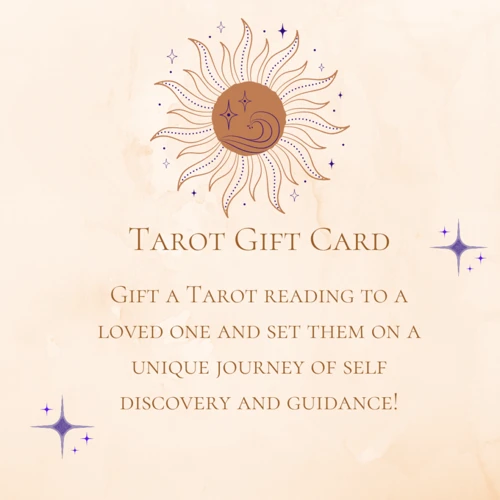
Experiences and testimonials are powerful tools for understanding and appreciating the impact of tarot in occult and esoteric practices. Many individuals have found solace, guidance, and personal growth through their encounters with tarot readings. One common experience shared by those who have sought tarot readings is the illumination and validation it brings. Tarot readings have a way of shedding light on hidden aspects of a person’s life, helping them gain new perspectives and insights. These readings often provide a sense of validation, as the cards mirror the individual’s experiences and emotions. Testimonials often highlight how tarot readings have been transformative, empowering individuals to make informed decisions and navigate through life’s challenges with clarity and confidence. Many have reported a deep connection with their intuitive selves during tarot readings, where they feel a strong sense of resonance and truth. The personal and profound experiences shared by individuals have played a significant role in the widespread popularity and belief in the efficacy of tarot. It is these testimonials that continue to attract individuals to explore tarot’s mysteries, benefiting from its wisdom and guidance.
The Future of Tarot
The future of tarot is a subject of great curiosity and speculation. As society continues to evolve, so too does the practice and interpretation of tarot. One aspect that seems certain is the increasing accessibility of tarot. With the advent of technology, tarot readings can now be conducted online, making it easier than ever for individuals to seek guidance and insight. However, this convenience also raises questions about the authenticity and accuracy of digital tarot readings. There is a growing debate within the tarot community regarding the ethics and effectiveness of these virtual readings. While some embrace the integration of technology, others emphasize the importance of personal connection and the tactile experience of shuffling physical cards.
Another potential future trend of tarot is its increasing acceptance and integration into mainstream culture. Tarot is gradually shedding its past stigma and being recognized as a valuable tool for self-reflection, personal growth, and even psychological exploration. More people are turning to tarot as a means of navigating life’s challenges and finding clarity in a chaotic world. As this acceptance grows, we may see tarot become more integrated into therapeutic practices, counseling sessions, and wellness retreats.
There is a push for inclusivity within the tarot community. Traditionally, tarot decks have often depicted predominantly white, cisgender individuals. However, there is a growing movement to create tarot decks that reflect diverse cultures, identities, and experiences. This shift towards inclusivity aims to make tarot a more relatable and accessible tool for individuals from all walks of life. As a result, we may see a greater variety of tarot decks that cater to diverse religious beliefs, spiritual practices, and cultural traditions.
The future also holds possibilities for innovative approaches to tarot. Some practitioners are experimenting with incorporating technology, such as virtual reality, into tarot experiences, offering a more immersive and interactive reading. Others are exploring the use of astrology and other divination systems in conjunction with tarot to provide more holistic insights.
While the future of tarot holds many exciting prospects, it is important to remember that the essence of tarot lies in its timeless wisdom and intuitive connection. No matter how it may evolve, tarot will always serve as a powerful tool for self-reflection, guidance, and spiritual exploration.
Conclusion
In conclusion, the role of tarot in occult and esoteric practices is a multifaceted and captivating subject. Throughout history, tarot cards have served as a powerful tool for divination, spiritual guidance, ritualistic practices, and self-reflection. The symbolism embedded within the cards allows individuals to tap into their intuition and connect with the collective unconscious. Tarot has also found correlations with astrology, further expanding its applications and insights. It is important to approach tarot readings ethically, respecting boundaries, confidentiality, and free will. Choosing the right tarot deck is a personal journey, where affinity with artistic styles and symbolism plays a significant role. Learning tarot requires a study of card meanings and the development of intuitive reading skills. The experiences and testimonials of those who have delved into the world of tarot highlight its profound impact on their lives. As the future unfolds, tarot will undoubtedly continue to evolve and inspire individuals on their spiritual paths. Whether as a practitioner or a curious observer, the world of tarot invites us to explore the mysteries of the human psyche and the hidden realms of the occult.
Frequently Asked Questions
What is tarot divination?
Tarot divination is the practice of using tarot cards to gain insight, guidance, and understanding into various aspects of life, including love, career, and personal growth. It involves interpreting the imagery and symbolism within tarot cards to provide meaningful and relevant messages.
How accurate are tarot readings?
Accuracy in tarot readings can vary and is dependent on several factors, including the reader’s skill and intuition, the clarity of the question asked, and the openness of the person receiving the reading. While tarot readings can provide valuable insights and perspectives, it is important to remember that they are not absolute predictions of the future.
Can anyone learn to read tarot cards?
Yes, anyone can learn to read tarot cards with dedication, practice, and a willingness to develop intuitive abilities. It is important to study the meanings and symbolism of the cards, apply different reading techniques, and trust your instincts when interpreting the cards.
What are the major and minor arcana in tarot?
The tarot deck is divided into two main sections: the major arcana and the minor arcana. The major arcana consists of 22 cards that represent significant life events, archetypes, and spiritual lessons. The minor arcana consists of 56 cards grouped into four suits (Cups, Pentacles, Swords, and Wands), representing day-to-day experiences and challenges.
Are there different variations of tarot decks?
Yes, there are numerous variations of tarot decks available, each with its own unique artwork, symbolism, and interpretations. Some popular variations include the Rider-Waite-Smith deck, Thoth deck, Marseille deck, and modern-themed decks that cater to different spiritual and personal preferences.
How can tarot cards be used for spiritual guidance?
Tarot cards can be used as a tool for spiritual guidance by tapping into one’s intuition and connecting with higher consciousness. Through tarot readings, individuals can gain insights, reflect on life patterns, and receive guidance to navigate their spiritual journeys with clarity and empowerment.
What is the connection between tarot and astrology?
Tarot and astrology are interconnected in various ways. Some tarot decks incorporate astrological symbols and correspondences on the cards, allowing for deeper insights and interpretations. Additionally, tarot spreads can be used in conjunction with astrological charts to provide more comprehensive readings.
How can I choose the right tarot deck for me?
Choosing the right tarot deck is a personal decision and depends on your preferences and resonance with the artwork, symbolism, and energy of the deck. It is recommended to explore different decks, read reviews, and see which deck attracts you intuitively.
Is it necessary to have psychic abilities to read tarot?
No, it is not necessary to have psychic abilities to read tarot. While psychic abilities can enhance the reading experience, tarot is a practice that can be learned and developed by anyone, regardless of their psychic sensitivity. Tarot relies on intuition, symbolism, and personal interpretation.
How can I learn tarot card meanings?
Learning tarot card meanings involves studying the individual cards, their symbols, and their archetypal meanings. It is helpful to work with a tarot guidebook or take courses that provide detailed explanations of each card. Daily practice and reflection on the cards will deepen your understanding and intuition.






